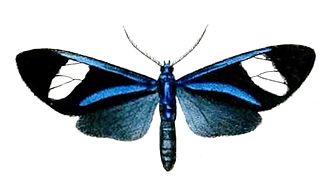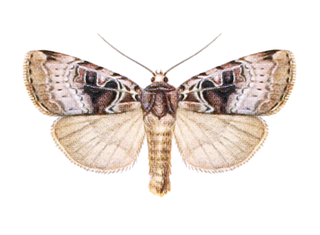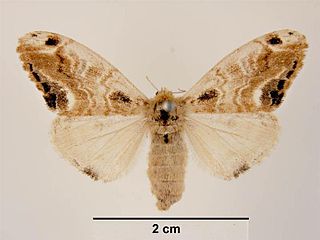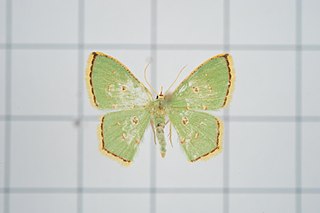
Ypsolophidae is a family of moths with some 160 species. They are included in the Plutellidae by many authors.

Actias is a genus of Saturniid moths, which contains the Asian-American moon moths. Long tails on their hindwings are among their distinctive traits. Other moths with similar appearance are Copiopteryx, Argema and Eudaemonia.

Euagra is a genus of moths in the subfamily Arctiinae. The genus was erected by Francis Walker in 1854.

Diacrisia sannio, the clouded buff, is a moth of the family Erebidae. The species was first described by Carl Linnaeus in his 1758 10th edition of Systema Naturae. It is found in the Palearctic realm from Ireland to Siberia. It is not found in North Africa. In the Russian Far East, eastern China, Korea, and Japan it is replaced by Diacrisia irene.

Pelosia is a genus of moths in the family Erebidae. The genus was erected by Jacob Hübner in 1819.

Drepana curvatula, the dusky hook-tip, is a moth of the family Drepanidae. It was first described by Moritz Balthasar Borkhausen in 1790 and it is found from Europe to Japan.
Koyaga is a genus of moths of the family Noctuidae. The genus was described by Ueda in 1984.

Myrteta is a genus of moths in the family Geometridae. It was first described by Francis Walker in 1861.

Xestia kollari is a moth of the family Noctuidae. It is known from the southern Urals to the Amur Region, northern Mongolia, Korea, Japan as well as from China, Ussuri and Kamchatka.

Orgyia thyellina, the white-spotted tussock moth, is a species of moth of the subfamily Lymantriinae first described by Arthur Gardiner Butler in 1881. It is native to the Russian Far East, Japan, Korea, Taiwan, and China. It was discovered in Auckland, New Zealand, in 1996. Operation Ever Green was established that same year to eradicate the pest. By 1998, the species was eradicated. It is thought of as one of the most successful eradication programmes ever undertaken in an urban area.

Garaeus specularis is a moth of the family Geometridae first described by Frederic Moore in 1868. It is found from India to Japan.
Cataprosopus is a genus of the snout moth. It was described by Arthur Gardiner Butler in 1881 and is known from India, China, and Japan.
Scopula impersonata is a moth of the family Geometridae. It is found in China, the Russian Far East, Taiwan and Japan.

Scopula luridata is a moth of the family Geometridae. It is found in southern Europe, Asia Minor, China, Pakistan, India, Egypt, Somalia, Yemen, Oman and Japan.
Pseudostegania defectata is a moth in the family Geometridae. It is found in the Russian Far East and Japan.

Elophila turbata is a moth in the family Crambidae found in Africa and Asia. It was first described by the English entomologist Arthur Gardiner Butler in 1881 from a specimen found in Yokohama, Japan.
Pyrausta chrysitis is a moth in the family Crambidae. It was described by Arthur Gardiner Butler in 1881. It is found in Japan.
Hydrorybina pryeri is a moth in the family Crambidae. It was described by Arthur Gardiner Butler in 1881. It is found in Japan and Russia.
Schistomitra is a monotypic moth genus in the family Epicopeiidae described by Arthur Gardiner Butler in 1881. Its only species, Schistomitra funeralis, was described by the same author in the same year. It is found in western Japan, where it has been recorded from central to western Honshu and Shikoku.

Comostola subtiliaria is a moth of the family Geometridae first described by Otto Vasilievich Bremer in 1864. It is a widespread species which is found in Korea and adjacent parts of Siberia, Japan, Borneo, Sumatra, India, South China, Taiwan, Borneo, Sumatra, and Sri Lanka.














